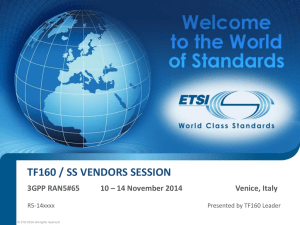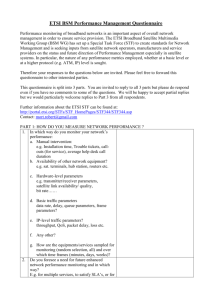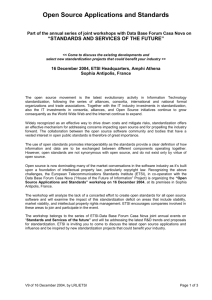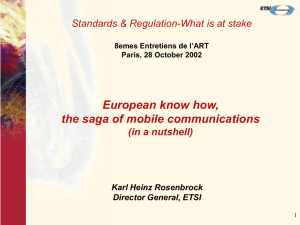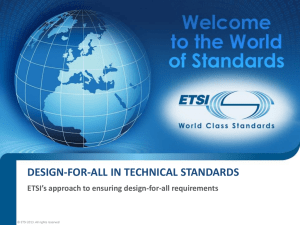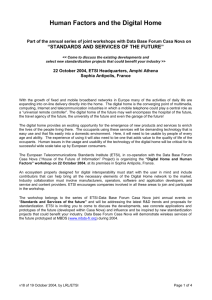World Class Standards
advertisement
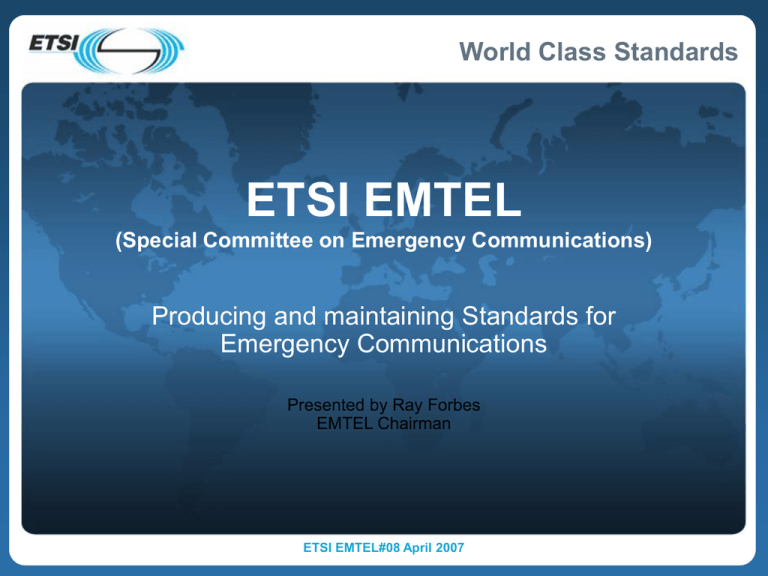
World Class Standards ETSI EMTEL (Special Committee on Emergency Communications) Producing and maintaining Standards for Emergency Communications Presented by Ray Forbes EMTEL Chairman ETSI EMTEL#08 April 2007 World Class Standards What are Emergency Telecommunications Emergency telecommunications covers all communication services, including voice and non-voice, data, location ect… The need for emergency telecommunications includes many scenarios ranging from: a minor road traffic accident, for example to a major incident like a passenger train crash, a terrorist incident, a natural disaster (e.g. an Earthquake, Tsunami). Provision for emergency telecommunications is also a major requirement in disaster situations ETSI EMTEL#08 April 2007 2 World Class Standards History of SC EMTEL EMTEL was previously OCG EMTEL: ETSI Board created an ad hoc group for coordination of Emergency Telecommunication activities Then the group became Special Committee (SC) EMTEL: It has been created and approved by Board#50 in February 2005 SC EMTEL shall report directly to the ETSI Board ETSI EMTEL#08 April 2007 3 World Class Standards Main responsibilities of EMTEL Act as a key coordinator in getting requirements on Emergency Communications, outside ETSI (i.e. from different stakeholders) and inside ETSI (i.e. ETSI Bodies). Provide requirements on issues of network security, network integrity, network behavior in emergency situations, and emergency telecommunications needs in networks Co-ordinate the ETSI positions on EMTEL related issues Be the Interface for emergency communications issues between ETSI and CEC/EFTA, NATO, ITU groups, the CEPT ERO and relevant CEN and CENELEC committees ETSI EMTEL#08 April 2007 4 World Class Standards User requirements and scenarios The requirements are collected to ensure: Communication of individuals with authorities Communication from authorities to Individuals Communication between authorities Communication amongst individuals Generally agreed categories to be considered in the provision of emergency communications for practically all types of scenario Including communications resilience and network preparedness ETSI EMTEL#08 April 2007 5 World Class Standards EMTEL Document Structure AFTER DURING INITIAL WARNING Emergency Individuals to Authority Authority to Authority Authority to Individuals Between Individuals ETSI EMTEL#08 April 2007 6 World Class Standards Fixed or Mobile technology? Communication for: Individuals to Authority’, ‘Authority to Individuals’ and ‘Individuals to Individuals’ for Voice and data service from both wireless and wireline access (including normadicity on fixed line users) Public broadcast services (often used also): in support of ‘Authority to Individuals’ communications Both fixed and mobile technologies: for ‘Authority to Authority’ communications utilized by public safety organizations in Europe already (same technologies as those used for routine public safety telecommunications) ETSI EMTEL#08 April 2007 7 World Class Standards Private or Public networks? Telecommunication technologies used for emergency telecommunications are often no different than those used for routine public safety telecommunications Sharing of networks with non-public safety users is commonplace Wireless technologies are likely to be combination of narrowband, wideband and broadband, and nature of application use public or private networks Public: GPRS and 2/3G Private: Wideband TEDS and Broadband PPDR Migration toward IP technologies the private access mobility & nomadicity between public and private access will be common A combination of both proprietary and ETSI telecommunication technologies are often used ETSI EMTEL#08 April 2007 8 World Class Standards Interfaces needed to access emergency services 1 2 5 4 PSAP Individuals 112 Telecom Emergency Call+ data PSAP ECC & Emergency Response 3 Backgrund info Other info providers 1. 2. 3. 4. 5. Additional info Look up. Medical info Houseowners GIS etc Individuals emergency call to authority/ PSAP PSAP Required Information related to 112 call Other data information Authority to Authority Authority to Individuals ETSI EMTEL#08 April 2007 9 World Class Standards Requirements and standardisation The roles of different groups Access to PSAP 112 IP Network Or Internet IP interface PSAP Telecom Telecpoms interface Expert Group on Emergency Access COCOM subgroup High level operational requirements Defines mandatory and optional requirements EMTEL Functional requirements (models) Elaborates the specification of functions Technical bodies (ETSI other groups, 3GPP, IETF etc.) Technical standards (implementation) Works out possible solutions Communications n/w ETSI EMTEL#08 April 2007 10 World Class Standards Requirements and standardisation Examples concerning VoIP Expert Group on Emergency Access COCOM subgroup High level requirements: Routing to ”right” PSAP Access to PSAP 112 IP Network Or Internet EMTEL Functional requirements: What is ”right” PSAP IP interface PSAP Telecom Telecpoms interface Technical bodies (ETSI other groups, 3GPP, IETF etc.) Technical standards: Solutions to find ”right” PSAP e.g. DNI-request Communications n/w ETSI EMTEL#08 April 2007 13 World Class Standards EMTEL ETSI published deliverables TS 102 182: Requirements for communications from authorities/organizations to individuals, groups or the general public during emergencies Revised and up issued to a Technical Specification to include parameterisation of the alerting requirements Published as a Technical Report in February 2006; Published as TS 102 182 in December 2006 TR 102 444: Analysis of the Short Message Service (SMS) and Cell Broadcast Service (CBS) for Emergency Messaging applications Published in March 2006 TR 102 445: Overview of Emergency Communications Network Resilience and Preparedness Published in November 2006 TR 102 180: Basis of requirements for communication of individuals with authorities/organizations in case of distress (Emergency call handling) Revised to include requirements for VoIP and Sip based Emergency and location services, capturing these requirements in a technology neutral way will also be considered Revision of SR 002 180, published in February 2007 ETSI EMTEL#08 April 2007 14 World Class Standards EMTEL published deliverables in revision SR 002 299: Collection of European Regulatory principles (may be revised to add PATS Regulation for ECNs) Published in April 2004; Re-opened in March 2007 revised to TR 102 299 TS 102 181: Requirements for communication between authorities/organizations during emergencies Reopened for consideration of inputs from ETSI TETRA Published in December 2005; Reopened in September 2006 ETSI EMTEL#08 April 2007 15 World Class Standards EMTEL ongoing deliverables TR 102 410: Basis of requirements for communications between individuals and between individuals and authorities whilst emergencies are in progress Stable and sent for comments in March 2007 TR 102 476: Emergency calls and VoIP: possible short and long term solutions and standardisation activities Structure stable in September 2006 approval aimed for June 2007 Alignment of Terminology for User/Individual Authorities/Organisation has been undertaken as requested at the GSC#9 meeting ETSI EMTEL#08 April 2007 16 World Class Standards EMTEL matters in other ETSI Bodies Although SC EMTEL was formed to specifically address public safety user requirements for Emergency Telecommunications, other Technical Bodies (TBs) within ETSI have been active for some time: Activity co-operating between 3GPP and ETSI TISPAN on the specification of a Mobile Location Positioning protocol for the delivery to the Emergency Authority the position of a caller to the Emergency Services ETSI TISPAN has approved the Emergency requirements for NGN Systems The definition of a SIP interface from the NGN system toward a PSAP may be under consideration, clarification of the need for this so called peer-to-peer sip interface is sought from the EU commission and PSAP Operators. Many standards related to EMTEL topics (more than 700) are developed by other ETSI Bodies i.e. 3GPP, TC TISPAN, EP MESA, TC TETRA and TC ERM ETSI EMTEL#08 April 2007 17 World Class Standards EMTEL matters in other ETSI Bodies You can find the main standards on the EMTEL Status Report page (ETSI Portal): http://portal.etsi.org/emtel/status.asp And for more details have a look at the ETSI Work Programme, advanced search, by selecting the project code EMTEL: http://webapp.etsi.org/WorkProgram/Expert/QueryForm.asp Liaisons are regularly exchanged with other ETSI Bodies ETSI EMTEL#08 April 2007 18 World Class Standards Co-operation with external Bodies A Memorandum of Understanding has been signed between ETSI and NENA (National Emergency Number Association) end of 2005, involving mainly EMTEL and TISPAN Regular liaisons are exchanged with TIA, ITU-T, NATO ETSI and NATO should organize a Civil Military Co-operation (CIMIC) workshop to look at how best provide communications at major incident/disaster scenarios. Date to be defined. ETSI EMTEL#08 April 2007 19 World Class Standards Cooperation with EU Projects EMTEL is involved in EU Projects eCall project (in-vehicle automatic emergency call), project required by the Commission to ETSI In co-ordination with TC MSG (Mobile Standards Group), TC ERM TG37 (Intelligent Transport Systems) and TC TISPAN (Telecoms & Internet converged Services & Protocols for Advanced Networks) TC MSG eCall agrees that the documentation of the eCall requirements will be discussed in 3GPP. ETSI EMTEL#08 April 2007 20 World Class Standards Thank you for your attention! Next EMTEL Meeting: 19th-21st June 2007 Trondheim Norway; hosted at the Technical University of Trondheim. For more details you can: Visit our ETSI EMTEL Portal: http://portal.etsi.org/portal_common/home.asp?tbkey1=EMTEL Browse the ETSI EMTEL Web site: www.emtel.etsi.org Don’t hesitate to contact me at: raymond.forbes@ericsson.com Or emtelsupport@etsi.org ETSI EMTEL#08 April 2007 21
